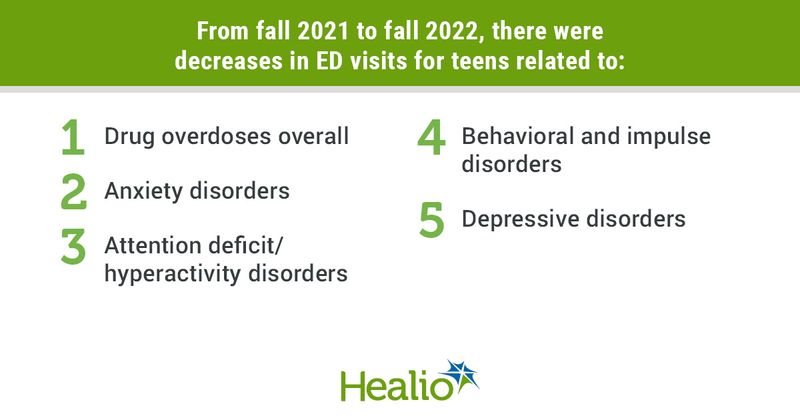Adolescents make fewer mental health-related emergency department visits as pandemic ebbs
Key takeaways:
- Data showed across-the-board decreases in adolescent ED visits for mental health issues since the fall of 2021.
- The authors cited a return to pre-pandemic conditions as a reason for the change.
Adolescent ED visits related to mental health decreased between 2021 and 2022 but remained elevated, especially among teen girls, according to findings published in MMWR.
Research has shown that mental health visits have been more common at pediatric EDs during the pandemic. The study published Thursday found that, compared with the fall of 2021, weekly ED visits for mental health conditions, suicide-related behaviors and drug overdoses decreased overall for boys and girls in the United States aged 12 to 17 years by fall 2022.

“Multiple reasons might account for these findings,” they wrote. “Many adolescents have returned to pre-pandemic-like school and community environments, which might have improved social engagement, reduced isolation, and supported mental and behavioral health for some adolescents. Familial or other stressors might also have declined, resulting in fewer adverse childhood experiences, which are strongly associated with adolescent mental and behavioral health.”
For their study, the researchers examined ED visit data from the National Syndromic Surveillance Program from January 2019 to early February 2023, comprising approximately 75% of EDs in the U.S.
By fall 2022, they noted average weekly adolescent ED visits decreased 11% overall, 12% for suicide-related behaviors, and 10% for drug overdoses compared with fall 2021. Decreases were also noted in visits for anxiety disorders, depressive disorders, ADHD, bipolar disorders, eating disorders, tic disorders and suspected suicide attempts.
The researchers said the findings indicate some improvements in the trajectory of adolescent mental health but they also noted that such conditions and behaviors continue to “persist at high rates, especially for teenage girls.”
“Weekly ED visits among females were at or higher than the pre-pandemic baseline for mental health conditions overall, suicide-related behaviors, and drug overdoses,” they wrote. “Early condition identification and trauma-informed interventions, coupled with evidence-based, comprehensive prevention efforts, are needed to support adolescents’ mental and behavioral health.”
